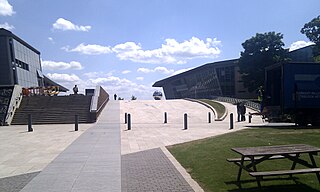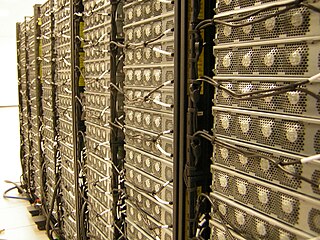
Blue Gene was an IBM project aimed at designing supercomputers that can reach operating speeds in the petaFLOPS (PFLOPS) range, with low power consumption.

The SIB Swiss Institute of Bioinformatics is an academic not-for-profit foundation which federates bioinformatics activities throughout Switzerland.

TeraGrid was an e-Science grid computing infrastructure combining resources at eleven partner sites. The project started in 2001 and operated from 2004 through 2011.

The Bio21 Institute of Molecular Science and Biotechnology, abbreviated as the Bio21 Institute, is an Australian scientific research institute that focuses on basic science and applied biotechnology. The Bio21 Institute is based at the University of Melbourne on Flemington Road in Parkville, Melbourne, Victoria.
In 2005, the McMaster School of Computational Engineering and Science was the first program launched in Canada dedicated in developing expertise in the third wave of scientific research involving simulation, modeling and optimization. The new school brings together 50 faculty from engineering, science, business and health science to collaboratively conduct research and advance education.
The Center for Computational Innovations (CCI), is a supercomputing center located at the Rensselaer Technology Park in Troy, New York.
The Texas Advanced Computing Center (TACC) at the University of Texas at Austin, United States, is an advanced computing research center that is based on comprehensive advanced computing resources and supports services to researchers in Texas and across the U.S. The mission of TACC is to enable discoveries that advance science and society through the application of advanced computing technologies. Specializing in high performance computing, scientific visualization, data analysis & storage systems, software, research & development and portal interfaces, TACC deploys and operates advanced computational infrastructure to enable the research activities of faculty, staff, and students of UT Austin. TACC also provides consulting, technical documentation, and training to support researchers who use these resources. TACC staff members conduct research and development in applications and algorithms, computing systems design/architecture, and programming tools and environments.
The myGrid consortium produces and uses a suite of tools design to “help e-Scientists get on with science and get on with scientists”. The tools support the creation of e-laboratories and have been used in domains as diverse as systems biology, social science, music, astronomy, multimedia and chemistry.
The European Molecular Biology network (EMBnet) is an international scientific network and interest group that aims to enhance bioinformatics services by bringing together bioinformatics expertises and capacities. On 2011 EMBnet has 37 nodes spread over 32 countries. The nodes include bioinformatics related university departments, research institutes and national service providers.

The Wellcome Genome Campus is a scientific research campus built in the grounds of Hinxton Hall, Hinxton in Cambridgeshire, England.
The National Center for Computational Sciences (NCCS) is a United States Department of Energy (DOE) Leadership Computing Facility that houses the Oak Ridge Leadership Computing Facility (OLCF), a DOE Office of Science User Facility charged with helping researchers solve challenging scientific problems of global interest with a combination of leading high-performance computing (HPC) resources and international expertise in scientific computing.
Shaheen is the name of a series of supercomputers owned and operated by King Abdullah University of Science and Technology (KAUST), Saudi Arabia. Shaheen is named after the Peregrine Falcon. The most recent model, Shaheen II, is the largest and most powerful supercomputer in the Middle East.
The Victorian Partnership for Advanced Computing (VPAC) was a leading, independent advanced computing R&D service provider and not-for-profit research agency established in 2000 by a consortium of Victorian universities: Deakin University, La Trobe University, Monash University, RMIT University, Swinburne University of Technology, The University of Melbourne, University of Ballarat, Victoria University.

SciNet is a consortium of the University of Toronto and affiliated Ontario hospitals. It has received funding from both the federal and provincial government, Faculties at the University of Toronto, and affiliated hospitals.

Several centers for supercomputing exist across Europe, and distributed access to them is coordinated by European initiatives to facilitate high-performance computing. One such initiative, the HPC Europa project, fits within the Distributed European Infrastructure for Supercomputing Applications (DEISA), which was formed in 2002 as a consortium of eleven supercomputing centers from seven European countries. Operating within the CORDIS framework, HPC Europa aims to provide access to supercomputers across Europe.

The iPlant Collaborative, renamed Cyverse in 2017, is a virtual organization created by a cooperative agreement funded by the US National Science Foundation (NSF) to create cyberinfrastructure for the plant sciences (botany). The NSF compared cyberinfrastructure to physical infrastructure, "... the distributed computer, information and communication technologies combined with the personnel and integrating components that provide a long-term platform to empower the modern scientific research endeavor". In September 2013 it was announced that the National Science Foundation had renewed iPlant's funding for a second 5-year term with an expansion of scope to all non-human life science research.
ELIXIR is an initiative that allows life science laboratories across Europe to share and store their research data as part of an organised network. Its goal is to bring together Europe's research organisations and data centres to help coordinate the collection, quality control and storage of large amounts of biological data produced by life science experiments. ELIXIR aims to ensure that biological data is integrated into a federated system easily accessible by the scientific community.

The Australia Bioinformatics Resource (EMBL-ABR) was a significant initiative under the associate membership to EMBL.
QFAB Bioinformatics is a Queensland-based organisation concerned with the provision of resources in bioinformatics, biostatistics and specialised computing platforms. QFAB operates Australia-wide and is a key contributor to the EMBL Australia Bioinformatics Resource.










